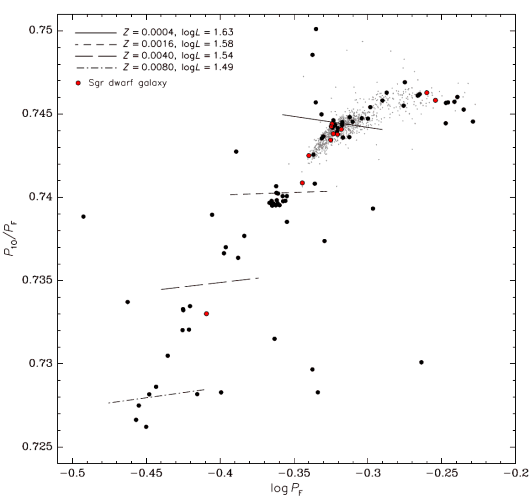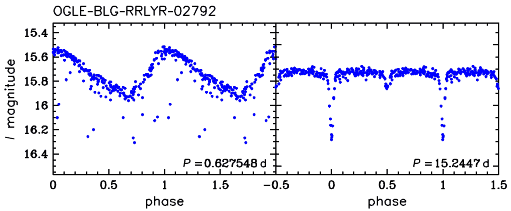The OGLE-III Catalog of Variable Stars
XI. RR Lyrae Stars in the Galactic Bulge
The eleventh part of the OGLE-III Catalog of Variable Stars (OIII-CVS) contains 16836 RR Lyr stars detected in the OGLE fields toward the Galactic bulge. The total sample is composed of 11756 RR Lyr stars pulsating in the fundamental mode (RRab), 4989 overtone pulsators (RRc), and 91 double-mode (RRd) stars. About 400 RR Lyr stars are members of the Sagittarius Dwarf Spheroidal Galaxy. The catalog includes the time-series photometry collected in the course of the OGLE survey, basic parameters of the stars, finding charts, and cross-identifications with other catalogs of RR Lyr stars toward the Milky Way center.

We notice that some RRd stars in the Galactic bulge show unusually short periods and small ratio of periods, down to PF=0.35 days and P1O/PF=0.726. In the Petersen diagram double-mode RR Lyr stars form a parabola-like structure, which connects shorter- and longer-period RRd stars. We show that the unique properties of the bulge RRd stars may be explained by allowing for the wide range of the metal abundance extending up to [Fe/H]=-0.36.

We report the discovery of an RR Lyr star with additional eclipsing variability with the orbital period of 15.2447 days. Some statistical features of the RR Lyr sample are presented. We discuss potential applications of our catalog in studying the structure and history of the central region of the Galaxy, mapping the interstellar extinction toward the bulge, studying globular clusters and the Sagittarius Dwarf Galaxy.

For each object the multi-epoch V- and I-band photometry collected over 8 or 13 years of observations and finding charts are available to the astronomical community from the OGLE Internet archive.
PLEASE cite the following paper when using the data or referring to these OGLE results:
Soszyński et al., 2011,
Acta Astron., 61, 1
(arXiv:1105.6126)
Any comments about the data and the form of their presentation are welcome as they can improve the future releases of catalogs of variable stars detected by the OGLE collaboration. Send your messages to this address.
 back
back